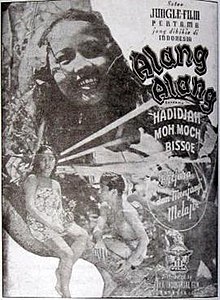Alang-Alang (film)
| Alang-Alang | |
|---|---|
 Theatrical poster | |
| Directed by | The Teng Chun |
| Written by | The Teng Chun |
| Produced by | The Teng Chun |
| Starring |
|
| Music by | Mas Sardi |
Production company | Java Industrial Film |
Release date |
|
| Country | Dutch East Indies (now Indonesia) |
| Language | Malay |
Alang-Alang (taken from the Indonesian word for
Plot
Suhiyat (Mohamad Mochtar), a young man who enjoys partying, is sent to manage a coconut plantation. He stays with a young widow named Rasmina (Lena) and falls in love with a local girl named Surati (Hadidjah); Rasmina, who is loved by Karta (Musa), also falls in love with Suhiyat. Meanwhile, a local thug named Rainan (Bissoe) has also fallen in love with Surati. To ensure success with Suhiyat, Rasmina pays Rainan to marry Surati. When Surati refuses, however, Rainan kidnaps her and escapes by boat. Their boat sinks and the two wash ashore on an island, not knowing that the other has survived. Surati befriends the local beasts, while Rainan finds other criminals and becomes their leader.
The loss of Surati makes Suhiyat feel depressed, which results in Rasmina feeling guilty over her actions. She is able to discover where Rainan and Surati are, and is able to command the local elephants to prevent Rainan's men from kidnapping Surati again. Meanwhile, Suhiyat has also come to the island and finds Surati. The two speak in the forest, but more of Rainan's men appear and kidnap Surati.
To rescue her, Suhiyat poses as a bandit and sneaks into the criminals' camp. He finds Surati and rescues her, only to be confronted by Rainan. After a ferocious struggle, Surati and Suhiyat escape into the forest, followed by Rainan and his men. As it appears they will be captured, Rasmina appears with some police, who capture the bandits. Rasmina tells Suhiyat that his father has died and left him a large inheritance. Suhiyat marries Surati, while Rasmina marries Karta.
Production
Alang-Alang was produced by Java Industrial Film under
The cast stage actor Musa in the role of Karta, then went looking for a person to play Suhiyat. He met with Mohamad Mochtar, a
Release and reception
Alang-Alang was released in November 1939[1] and advertised as the country's first jungle film;[2] its screenings continued into 1940.[4] Alang-Alang was a commercial success in both the Indies and British Malaya. This led to Mochtar receiving the nickname Tarzan van Java (Tarzan of Java)[4][6] and signing with Java Industrial Film for future roles.[7] Shots from Alang-Alang were later reused for the 1940 film Rentjong Atjeh, another Java Industrial Film production featuring Mohamad Mochtar.[8]
The film historian Misbach Yusa Biran credits the success of Alang-Alang and the earlier films Terang Boelan (1937) and Fatima (1938) as solidifying the film industry of the Dutch East Indies,[3] while the scholar of Malaysian culture Khoo Gaik Cheng credits it and Terang Boelan with jump starting the Malaysian and Singaporean film industries.[6] Alang-Alang was among the first films in the country to be heavily influenced by Western works; other such films included Kedok Ketawa (1940) and Tengkorak Hidoep (1941), both influenced by Bram Stoker's Dracula.[9]
See also
References
- Footnotes
- ^ a b Biran 2009, p. 382.
- ^ a b c Biran 2009, pp. 178–179.
- ^ a b c Biran 2009, p. 182.
- ^ a b c Biran 2009, p. 181.
- ^ Imanjaya 2006, p. 109.
- ^ a b Cheng 2006, p. 90.
- ^ Sinamatek Indonesia, Moh Mochtar.
- ^ Biran 2009, p. 210.
- ^ Imanjaya 2006, p. 38.
- Bibliography
- ISBN 978-979-3731-58-2.
- Cheng, Khoo Gaik (2006). Reclaiming Adat: Contemporary Malaysian Film and Literature. Vancouver: UBC Press. ISBN 978-0-7748-1173-6.
- Imanjaya, Ekky (2006). A to Z about Indonesian Film (in Indonesian). Bandung: Mizan. ISBN 978-979-752-367-1.
- "Moh Mochtar" (in Indonesian). Sinamatek Indonesia. Archived from the original on 9 July 2012. Retrieved 9 July 2012.
External links
- Alang-Alang at IMDb
